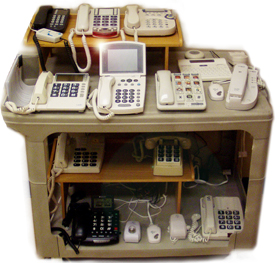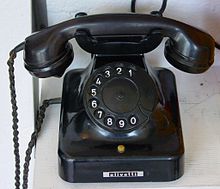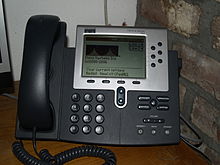
|
A rotary dial telephone, c.1940s
|
A hardware-based IP phone, with touch-tone dialing
|
|
Types Telecommunications equipment can be broadly broken down into the following categories: Public switching equipment Analogue switches Digital switches Transmission equipment Transmission lines Optical fiber Base transceiver stations Multiplexers Local loops Communications satellites Customer premises equipment Switches Local area networks Modems Mobile phones Landline telephones Answering machines Teleprinters Fax machines Pagers Routers Switches Networking hardware Networking hardware may also be known as network equipment, computer networking devices. Units which are the last receiver or generate data are called hosts or data terminal equipment. All these terms refer to devices facilitating the use of a computer network. Specifically, they mediate data in a computer network. Specific devices Gateway: this device is placed at a network node and interfaces with another network that uses different protocols. It works on OSI layers 4 to 7. Router: a specialized network device that determines the next network point to which it can forward a data packet towards the ultimate destination of the packet. Unlike a gateway, it cannot interface different protocols. It works on OSI layer 3. Switch: a device that allocates traffic from one network segment to certain lines (intended destination(s)) which connect the segment to another network segment. Unlike a hub, a switch splits the network traffic and sends it to different destinations rather than to all systems on the network. It works on OSI layer 2. Bridge: a device that connects multiple network segments along the data link layer. It works on OSI layer 2. Hub: a device that connects multiple Ethernet segments, making them act as a single segment. When using a hub, every attached device shares the same broadcast domain and the same collision domain. Therefore, only one computer connected to the hub is able to transmit at a time. Depending on the network topology, the hub provides a basic level 1 OSI model connection among the network objects (workstations, servers, etc.). It provides bandwidth which is shared among all the objects, in contrast to switches, which provide a connection between individual nodes. It works on OSI layer 1. Repeater: a device which amplifies or regenerates digital signals received while sending them from one part of a network into another. It works on OSI layer 1. Multilayer switch: a switch which, in addition to switching on OSI layer 2, provides functionality at higher protocol layers. Protocol converter: a hardware device that converts between two different types of transmission, such as asynchronous and synchronous transmissions. Bridge router (brouter): a device that combines router and bridge functionality and therefore works on OSI layers 2 and 3. Proxy server: computer network service which allows clients to make indirect network connections to other network services. Firewall: a piece of hardware or software put on the network to prevent some communications forbidden by the network policy. Network address translator (NAT): network service provided as hardware or software that converts internal to external network addresses and vice versa. Multiplexer: a device that combines several electrical signals into a single signal. Network interface controller: a piece of computer hardware allowing the attached computer to communicate by network. Wireless network interface controller: a piece of computer hardware allowing the non-attached computer to communicate by LAN. Modem: device that modulates an analog "carrier" signal (such as sound) to encode digital information, and that also demodulates such a carrier signal to decode the transmitted information, such as a computer communicating with another computer over a telephone network. ISDN terminal adapter (TA): a specialized gateway for ISDN. Line driver: a device to increase transmission distance by amplifying the signal; used in base-band networks only. Here are further guidelines. |
